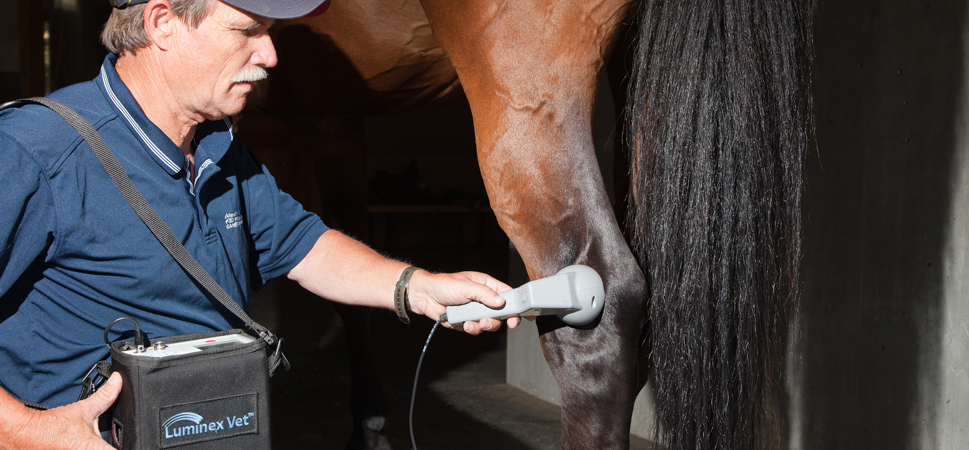Exploring the Holistic Strategy of Equine Therapy for Personal Growth
Exploring the Holistic Strategy of Equine Therapy for Personal Growth
Blog Article
Just How Laser Therapy in Horse Treatment Is Reinventing Vet Treatment for Equines
Laser treatment has become a transformative approach in equine veterinary treatment, offering a non-invasive remedy that accelerates recovery and improves total health. Leveraging exact light wavelengths, this innovative therapy boosts cellular regeneration, minimizes inflammation, and reduces discomfort. Its efficacy expands from bone and joint injuries to persistent ailments like osteoarthritis, substantially boosting movement and life high quality for steeds. The mobility and versatility of laser therapy gadgets even more underscore their expanding necessity among veterinarians. As we discover the elaborate technicians and real-world successes, the profound effect on equine clinical techniques becomes progressively evident.
Recognizing Laser Treatment

The innovation behind laser treatment is grounded in the concept of photochemistry, where photons are taken in by chromophores within cells, leading to boosted ATP production and inflection of reactive oxygen species (Equine Therapy). This, in turn, promotes cellular expansion, decreases swelling, and speeds up recovery. Vet practitioners use different sorts of lasers, consisting of low-level lasers (LLLT) and high-power Class IV lasers, relying on the certain restorative goals and the nature of the equine problem being dealt with
Various laser wavelengths and power settings are meticulously selected to target numerous cells midsts and attain preferred professional outcomes. Security protocols are extremely important, as incorrect use can result in thermal damages or suboptimal healing results. Thus, a thorough understanding of laser therapy's systems and applications is vital for its effective application in equine vet method.
Benefits for Equine Health
The myriad benefits of laser treatment for equine health encompass boosted recovery, discomfort reduction, and boosted flexibility. This innovative therapy technique leverages details wavelengths of light to permeate tissues, stimulating mobile function and advertising fast cells fixing. The non-invasive nature of laser therapy ensures very little tension and discomfort for the steed, helping with a smoother recovery procedure.
Boosted recovery is one of the leading benefits, as laser treatment speeds up mobile regeneration and collagen synthesis. Pain decrease is achieved through the anti-inflammatory impacts of laser treatment, which reduces swelling and reduces the production of pain-inducing chemicals.
Better flexibility is an additional critical advantage, especially for efficiency and working equines. By decreasing inflammation and pain, and improving tissue repair work, laser treatment helps in recovering joint function and muscle flexibility. The collective result of these advantages is not only a quicker return to normal activity yet additionally a general improvement in the steed's quality of life. Thus, laser treatment stands site link as a transformative tool in modern-day horse vet care.
Usual Conditions Dealt With
Laser therapy has arised as a functional therapy choice for a variety of usual equine problems. In addition, laser therapy is effective for problems like osteo arthritis, where it assists minimize joint inflammation and promote cells repair work.
Wound monitoring is another area where laser treatment has actually revealed considerable pledge. Persistent injuries or resource slow-healing abscess can be specifically tough in horses, however laser therapy boosts cellular regeneration and improves blood flow, hence quickening the healing procedure. Laser treatments have been effectively employed in handling unguis conditions such as laminitis and abscesses, reducing pain and promoting faster recuperation.

Innovation Behind Laser Therapy
Past the myriad problems treatable with laser treatment, the modern technology itself advantages closer assessment. At the heart of laser therapy is the usage of specific wavelengths of light to pass through tissues and evoke biological actions. These wavelengths, usually varying from 600 to 1000 nanometers, are uniquely taken in by chromophores in the skin, muscular tissue, and other tissues, initiating a cascade of cellular occasions.
Laser devices utilized in vet medication usually make use of low-level laser treatment (LLLT) or cold laser treatment. Unlike high-powered surgical lasers, these tools run at reduced energy levels, optimizing therapeutic advantages while lessening thermal damages. The power from the laser light promotes adenosine triphosphate (ATP) manufacturing, boosts cellular metabolism, and accelerates cells repair processes.

Success Stories and Study

Showcasing the tangible advantages of laser treatment, various success stories and study brighten its transformative influence on equine wellness. One such instance involves a pedigreed racehorse suffering from persistent tendonitis. Typical therapies yielded minimal improvement, but after integrating laser therapy into the regimen, the horse exhibited substantial decreases in company website swelling and pain within weeks, ultimately returning to affordable racing.
An additional compelling instance features a dressage equine identified with severe pain in the back, restricting its performance. A vet group used low-level laser therapy (LLLT) to target the inflamed locations, resulting in marked renovation in flexibility and a significant reduction in pain. Over numerous sessions, the horse restored its peak kind, showcasing the effectiveness of laser therapy in resolving musculoskeletal issues.
Additionally, a research performed at a leading equine clinic analyzed 50 equines with different soft cells injuries treated with laser treatment. The outcomes stood out: 85% of the equines demonstrated sped up healing times and enhanced mobility. These cases emphasize the adaptability and performance of laser treatment in equine medication, providing a non-invasive, scientifically-backed technique to boosting recuperation and performance in equines.
Final Thought
Laser therapy is transforming equine veterinary care by giving a non-invasive treatment that accelerates healing, reduces swelling, and relieves discomfort. With its performance in dealing with a variety of problems, from musculoskeletal injuries to chronic ailments like osteo arthritis, this technology considerably enhances equine wellness and mobility. The portability and flexibility of laser treatment better underscore its transformative influence on vet techniques, strengthening its function as a necessary tool in modern-day equine medical care.
Report this page